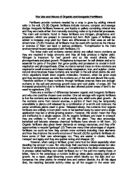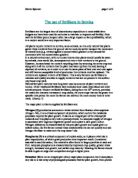There are a number of differences between organic and inorganic fertilisers and why one could be chosen over another. One advantage with organic fertilisers is that the nutrients are released at a slow steady rate, which suits plant growth. As the nutrients come from natural sources, a portion of them may be temporarily unavailable to plants until released by a combination of warmth and moisture; the same conditions plants need to grow. Released slowly, the nutrients from organic fertilizers are unlikely to burn plant roots or be leached away by water and a single application may last a whole growing season. However, this would mean that they are ineffective in a single season. (3) As organic fertilisers are lower in strength they are unlikely to “scorch” a root and kill the plant. They also encourage beneficial soil bacteria whereas chemical fertilisers have shown to kill them. (4) Organic fertilizers also place fewer demands on energy resources, and they offer opportunities to recycle "garbage". (3) There are many other advantages of organic fertilisers too such as how they contain more nutrients including trace elements and how they improve the crumb structure of the soil. (9) But synthetic fertilisers do have some of their own advantages too. They are easier to obtain, handle, transport and apply and they are quicker acting and cheaper. (9)
However, when using a fertiliser, great care must be taken especially when deciding the amount to use. Not only does their use have consequences but also the law of diminishing returns is present. Eutrophication is the direst consequence. A process called leaching can wash fertilisers out of the soil into nearby rivers or lakes. Here in the waterways a nutrient build-up takes place causing rapid plant growth. As a result, algal blooming occurs which blocks out the light and out competes the other plants for mineral ions and carbon dioxide. As all this algae dies, the resulting bacterial activity takes up all the oxygen in the water and biological oxygen demand takes place. This lack of oxygen causes the death of fishes and other animals in the water. (7) Therefore this chain of events caused by leaching can have very serious consequences. There is also an argument that suggests that highly soluble fertilisers lower pH making soils more acidic, which in turn leads to soil deterioration. However, right now this is mere speculation and the argument continues. (5) Other consequences with the use of fertilisers include how they may contain metal residues or plant and animal pathogens, which may enter a food chain causing disease. (7)
When deciding the quantity of fertiliser to use, as well as worrying about the consequences on the surroundings, we must also look at how it will affect the plant itself. A law of diminishing marginal returns exists so that as more and more fertiliser is added, the extra increase in yield gets smaller. This is because now there are other limiting factors such as temperature or light intensity. Fertiliser should only be added when nutrients are a limiting factor as these are what they are aiming to replace. (7) (8)
Therefore the use of fertilisers can be very useful indeed in increasing crop yield, especially in poorer areas of land. However, all fertilisers must be used with care and caution. Not only must the correct fertiliser be chosen (organic or inorganic) which is more suitable for the circumstances but also the quantity used is very important. Incorrect quantities can lead to the waste of fertilisers but also, more importantly, can have serious detrimental effects on the surrounding environment. However, reduction in diffuse pollution from agriculture can only be achieved by appropriate land management techniques and farmers need quality advice to enable this. Therefore, legislation has been passed by the Environment Agency and the Department for the Environment, Food and Rural Affairs (DEFRA) exists which produces guidelines for fertiliser use and draws up action plans for farmers in areas that are likely to exceed levels set by the European Union. (1) Other organisations also help such as the Fertiliser Manufacturers Association (FMA) which “represents the views and interests of the fertiliser industry to governments and to appropriate organisations and bodies, and promotes the proper and responsible use of fertilisers.” (2)
Words (excluding title and source references) = 982 words
Bibliography:
-
=
-
=
-
=
-
=
-
=
- = “The complete A-Z Biology Handbook” by B. Indge 1997
- = “AS Biology” by Mike Boyle 2000
- = “A new introduction to Biology” by B. Indge, M. Rowland and M. Baker 2000
- = “Biology for Advanced Level” – G. & S. Toole 1999
(10) = “Advanced Biology” – C.J. Clegg and D.G. Mackean 1994







